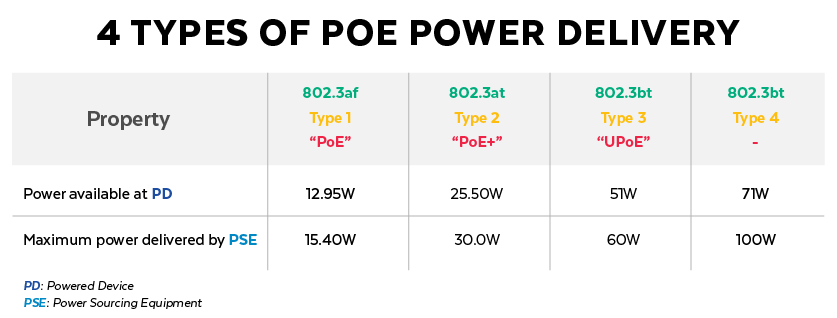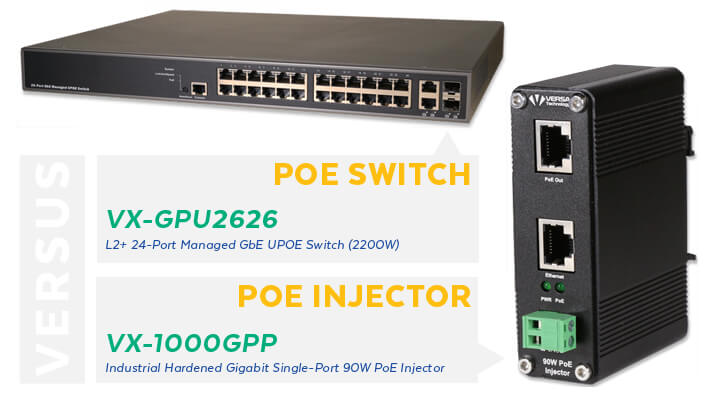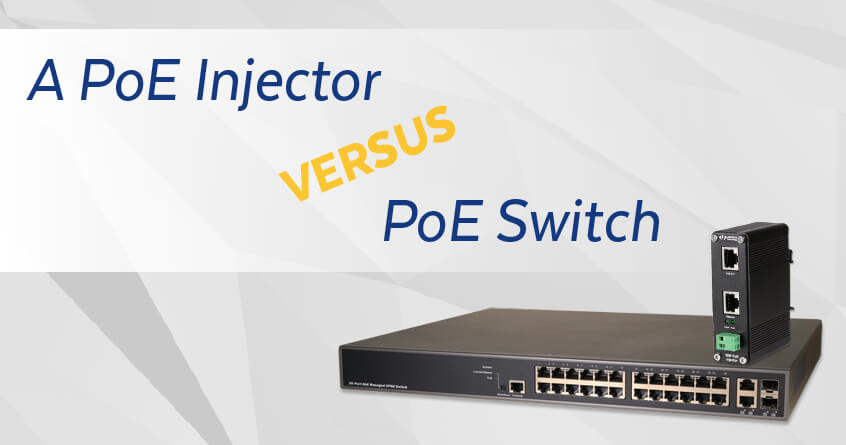The IT network is the lifeblood of any business, and Power over Ethernet (PoE) technology is saving companies a bundle while adding a single-cable solution for powering smart devices cross-platform. PoE adapts easily and scales to fit your implementation now, while also adjusting to fit new configurations as your needs morph down the road. Deploying an additional IP phone, camera or wireless access point does not have to break the bank. Depending on the power requirements of the PDs you’re supporting, you may opt for a solution other than a new switch. That’s because constructing or adding to an existing switch, even a loaded one, is simpler and less expensive than you might think. Getting the connectivity you need may be as simple as adding a PoE injector.
PoE And Your Cable Configurations
If you’re new to the current IEEE standards for 802.3 and the single-cable solution it offers, 802.3 divides into these four levels of power at port per device.

Each PD gains access to the network data through an Ethernet cable. Before PoE technology came on the scene, in addition to an Ethernet cable, each device also required a separate power cord.
As the number of devices began adding up, managing all these cables was time-consuming. The solution to cable mess came by combining data and power delivery over a single Cat5 Ethernet cable. Today, Cat 5 has been replaced by Cat5e, Cat6 and Cat6a, each providing a higher rate of noise and signal interference protection respectively.
The PSE supporting these PDs have not changed though. They are either PoE switches or PoE injectors. Knowing the best one for your implementation is the key to saving time and money. And, you’ll see that knowing which is really not difficult once you understand the unique features of either.
What a PoE Switch Offers
An IT network switch is a multiport network hardware device, connecting computers and smart devices and allowing them to send and receive data. The PSE supports the transfer of data between MAC addresses over the data link layer. As the PoE switch (or injector for that matter) connects to a device, it automatically determines whether that device is PoE compatible and whether it needs power.
By making sure any new switches are PoE Switches, you can ensure any PoE devices you need can easily connect to your network in the future. You’re also ensuring that you can connect non-PoE devices, as they will support both, without the risk of damage. There’s an automated step-down feature that allows each device to detect the presence of a PD, and to determine whether it receives data or data and power. This IEEE PoE protocol also allows PoE injector or switch to detect the power level it needs to deliver.
The delivery standard and amount of power each device needs is automated but you can know the requirements by looking at the IEEE 802.3 extension. For a type 1 device (IEEE 802.3af), the device can receive up to 15.4W of DC power safely. A type 2 device (IEEE 802.3at) receives up to 30W. The same is true for every port on the same switch–for type 1 switch 15.4W, for a type 2, 30W.
What a PoE Injector Offers
If you want to add either a PoE or non-PoE enabled device to a PoE switch, it works interchangeably. Not so for a non-PoE switch. And that’s one place a PoE injector comes in. A PoE injector allows you to connect your PoE-enabled PD to a non-PoE LAN switch port. It can plug into a PD and deliver power while the PD also receives data from the switch.
When spending the money for a switch isn’t practical, PoE injectors provide a versatile solution when fewer PoE ports are required.
When to Deploy a PoE Switch and When to Deploy a PoE Injector
A PoE switch is a self-contained solution that provides the data and power your network needs to function. That will support future device expansions as organizations increasingly add IoT devices to networks.
As the demand for higher power per port increases, though, choosing a PoE injector can be a much better option while saving IT administrators money. That’s because few switches offer more than 60W per port.
 When needing a large number of 90W ports, look for an Ultra PoE 802.3bt Ready switch like the VX-GPU2626 L2+ 24-Port Managed GbE UPOE Switch (2200W) to support higher-powered PDs.
When needing a large number of 90W ports, look for an Ultra PoE 802.3bt Ready switch like the VX-GPU2626 L2+ 24-Port Managed GbE UPOE Switch (2200W) to support higher-powered PDs.
When you only need one port, look for the VX-1000GPP Industrial Hardened Gigabit Single-Port 90W PoE Injector. It offers a power budget of up to 90W for a single port at a cost-effective price.
90W Power Devices
Why all of this emphasis on 90W? The higher power budget is particularly crucial for PoE lighting systems and platforms and for the other smart technologies currently being adopted. As businesses move further into the smart technologies, automation is also inching its way into the picture. Smart PDs are automated and automation needs more power.
The smart device customer is becoming aware of what’s possible with Ethernet power delivery and the IEEE 802.3bt, and is taking steps to upgrade his supporting infrastructure accordingly.
PoE-Powered LED Lighting
Facilities used to rely on AC wiring to power 90W LED lights. IEEE 802.3bt can now deliver up to 90W over PoE infrastructure to smart LED lighting systems with the new standard.
PTZ Cameras
IoT pan-tilt-zoom (PTZ) cameras with power budgets of up to 90W are rolling out in smart-city deployments.
High-Performance WAPs
Wireless Access Points (WAPs) are achieving higher levels of performance. That’s due to the rising demand for applications meeting the IEEE wireless standards of 802.11ax and 802.11ac Wave 2. In homes and the workplace demands for things like streaming video, are driving the development of wireless technologies in the ongoing 5G rollouts.
In some cases, 30W and 60W power levels must be reached for the WAPs to function. Further, access points draw up to 90W or more of pass-through power to deliver the juice for endpoint devices such as laptops.
Conclusion
A PoE injector with the 90W capability quickly adds onto existing networks without the need for additional switch purchases. They cost less and so are more easily approved and deployed. A PoE Switch is a fantastic investment and as the IoT continues developing. A PoE injector is a highly-responsive 90W, single-port alternative. Both of these PSEs are a welcome addition to inbuilding infrastructure, helping to keep your network expanding without a hefty financial outlay, and allowing your team to prioritize other projects without neglecting the end user.
Need help deciding which choice is better for your application? Feel free to reach out. We’d love to help.

